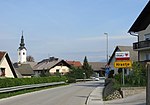Kranj
Cities and towns in Upper CarniolaKranjPages including recorded pronunciationsPages with Slovene IPAPopulated places in the City Municipality of Kranj

Kranj (pronounced [ˈkɾàːn] , German: Krainburg) is the third-largest city in Slovenia, with a population of 37,941 (2020). It is the seat of the City Municipality of Kranj. It is located approximately 20 kilometres (12 miles) northwest of Ljubljana in the traditional region of Upper Carniola (northwestern Slovenia). Kranj is a mainly industrial city with significant electronics and rubber industries.
Excerpt from the Wikipedia article Kranj (License: CC BY-SA 3.0, Authors, Images).Kranj
Planina, Kranj Orehek
Geographical coordinates (GPS) Address Nearby Places Show on map
Geographical coordinates (GPS)
| Latitude | Longitude |
|---|---|
| N 46.233333333333 ° | E 14.366666666667 ° |
Address
Planina
4000 Kranj, Orehek
Slovenia
Open on Google Maps






